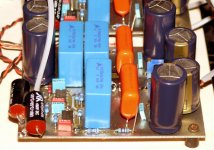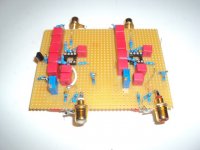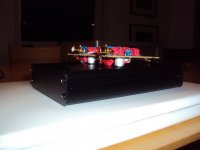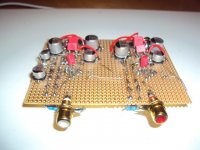Hi Joachim
I started reading this thread two weeks ago and did not reach half yet.
Did you finally experiment the transcondutance Riaa with Salas shunts ?
You work so much and post so many different schematics that it is very difficult for me to follow so I decided to go directly to the end.
Can you suggest a good DIY friendly schematic for a 0.15mV MC head amp ?
And what should be your last Riaa schematic for us DIY builders ?
Regards
Ricardo
I started reading this thread two weeks ago and did not reach half yet.
Did you finally experiment the transcondutance Riaa with Salas shunts ?
You work so much and post so many different schematics that it is very difficult for me to follow so I decided to go directly to the end.
Can you suggest a good DIY friendly schematic for a 0.15mV MC head amp ?
And what should be your last Riaa schematic for us DIY builders ?
Regards
Ricardo
Today i made more listening tests to loading resistors. The good news first : The 300 Ohm
TX resistor sounded much better then the 1Kohm. The thinness is gone replaced by a totally natural tonal balance. So again the message is that the value of the loading resistor is critical, maybe even more then the type provided you use a "good" one.
One remark : I whould rate both resistors to be in he same quality class so the Dale is a huge bargain when you have the space.
I completely agree that the Rload value is very important. A lower value resistor produces more tight bass and softens the spitty trebble.
Thank you for the Dale tip 🙂🙂🙂
You can not go wrong with this one. It is a very low noise transimpedance circuit and works well with very low output voltage cartridges. I original called it Nobrainer. Holger Barske made a PCB and Georg Stracke from Klangmeister build and tuned it. I just heard it today with an EMT and a Lyra Helicon in Georgs factory. The system, fully cranked up was quiet. You can contact Georg under Das Leben des Klangmeisters - Ideen, Neues, Köpfe - alles, was das Netzwerk ausmacht
There is an AC and DC version. The DC version has a servo. The drawing of the servo version has a mistake. The feedback resistor to ground is missing. The AC version shows the right value. Just take out the elcap to ground if you build the DC version. The PCB is for the DC version.
There is an AC and DC version. The DC version has a servo. The drawing of the servo version has a mistake. The feedback resistor to ground is missing. The AC version shows the right value. Just take out the elcap to ground if you build the DC version. The PCB is for the DC version.
Attachments
The input trimmer is for adjusting the input DC offset. First i whould set it aproximately to the midle position, then connect the cartridge and then measuring the offset from input to ground and adjusting it to zero. Even if the trimmer is set wrong, there is no risk of frying the cartridge but for best sound it is better to trim DC down.
I thought about this following small project hard and long. When i watch other threads about phonostages i can identify a desire for a stage that can be switched between MM and MC, is build from parts that are availlable, is inexpensive and easy to make, has good but not necessarily outstanding performance and is developped and build to a point so that complete information is availlable how to make it. Sofar i have focussed on testing all kinds of posibilities to make a phonostage and the plethora of circuits that surfaced may have confuse many. Some circuits made it onto a PCB though like the Nobrainer and i did an article for Jan Diddens Linear Audio that sums up a lot of work i did. A balanced In - balanced Out stage is described there in detail and a kit is availlable from Pilgham Audio. That circuit requires some knowlage and outlay though. Instead of finding the holy grail i know now after more then two years of hard and continuing work that it is not only the topology that counts but rather how a circuit is implemented and fine tuned that makes it tick. One could say that ones the design does the job well enough its the implementation that makes it tick. My plan for the next weeks is to focus on one circuit only and develop it to a point where anybody with decent soldering capabilities can make it without too much frustration.
The circuit i choose is nothing spectacular and the techniques are well known and proven. It is based on a workaround of my favourite Opamp of all time, the NE5534A. Yes, i know, there are better ones availlable now, most likely the LME series from National when it comes to bipolars. Nevertheless the NE has some features that are not availlable on newer designs, namely the Pins 1, 5 and 8 that give some access to the inner workings. To make a one stage design that acommodates MM and MC the best choice is a Fet input stage because there are some Fets on the market that have low voltage and current noise. Most known is the 2SK170 but also recently the very abundant BF862. Both have pros and cons and i will try to alaborate on that a bit. As far as i can see it the BF862 is better for low impedance work but should work well enough for MM too. So far i have only studied the Spec Sheet and Scott Wurzers measurements.
I have no practical experience with it but this is something i have to do in due course.
For today this is enough. I add a first sketch where you can study the principle. The input stage is switched off and the output stage is bypassed, the Vas biased. The first trick is well known since the NE came out and the second one i have simply coppied from a Headphone amp. I think it was on Headwize.
The circuit i choose is nothing spectacular and the techniques are well known and proven. It is based on a workaround of my favourite Opamp of all time, the NE5534A. Yes, i know, there are better ones availlable now, most likely the LME series from National when it comes to bipolars. Nevertheless the NE has some features that are not availlable on newer designs, namely the Pins 1, 5 and 8 that give some access to the inner workings. To make a one stage design that acommodates MM and MC the best choice is a Fet input stage because there are some Fets on the market that have low voltage and current noise. Most known is the 2SK170 but also recently the very abundant BF862. Both have pros and cons and i will try to alaborate on that a bit. As far as i can see it the BF862 is better for low impedance work but should work well enough for MM too. So far i have only studied the Spec Sheet and Scott Wurzers measurements.
I have no practical experience with it but this is something i have to do in due course.
For today this is enough. I add a first sketch where you can study the principle. The input stage is switched off and the output stage is bypassed, the Vas biased. The first trick is well known since the NE came out and the second one i have simply coppied from a Headphone amp. I think it was on Headwize.
Attachments
Hi Joachim
It looks very simple.... but the schematic needs revision... The letters appear on the second page.
I agree with you "it is not only the topology that counts but rather how a circuit is implemented and fine tuned that makes it tick."
It took me 2 years to fine tune my actual riaa preamp. The component choice and layout is very important. It is a matter of "voicing".
I find it most difficult to determine the best combinations for the riaa filter because it is very difficult to match caps and resistors. Appart from that, IMO the most important part is the PSU because the amplifier merely modulates it´s output. the PSU output impedance at different frequencies severely affects the overall tone.
Regards
Ricardo
It looks very simple.... but the schematic needs revision... The letters appear on the second page.
I agree with you "it is not only the topology that counts but rather how a circuit is implemented and fine tuned that makes it tick."
It took me 2 years to fine tune my actual riaa preamp. The component choice and layout is very important. It is a matter of "voicing".
I find it most difficult to determine the best combinations for the riaa filter because it is very difficult to match caps and resistors. Appart from that, IMO the most important part is the PSU because the amplifier merely modulates it´s output. the PSU output impedance at different frequencies severely affects the overall tone.
Regards
Ricardo
Last edited:
Hi Ricardo !
Yes, somehow the schematic appeared on the second page. I will look how to avoid that and post it again.
I found with capacitors that have a tolerance of say 10% ( for example Wima FKP-2 ) most of the batch is at the higher value but very similiar. So it is posible to use them and adjust the resistors acordingly. I think adjusting resistors is easier than sorting out the caps for the correct value. My aproach gives a little less gain then the theoretical values but it is not much and both channels are the same.
Yes, somehow the schematic appeared on the second page. I will look how to avoid that and post it again.
I found with capacitors that have a tolerance of say 10% ( for example Wima FKP-2 ) most of the batch is at the higher value but very similiar. So it is posible to use them and adjust the resistors acordingly. I think adjusting resistors is easier than sorting out the caps for the correct value. My aproach gives a little less gain then the theoretical values but it is not much and both channels are the same.
Nice.... 🙂
How do the big guys manage to sort caps and resistors in order to enter production ?
How do the big guys manage to sort caps and resistors in order to enter production ?
There are some caps availlable in 1%. For example Röderstein MKP and LCR Polystyren. I spot them here and there for example Röderstein in the Burmester and LCR in the Self phonostage made by The Signal Company. The next best thing is Wima FKP-2 in 2%. Wima also selects to 1% if you order in quantity. I also use Rifa PPS SMD caps that i sort out myself.
Same phenomenon like the Wimas. They usually err on the high side. Of cause you could use boutique caps from Mundorf ( they are usually 2% but Mundorf selects for you if you wish ), Rel Cap, V-Cap teflon, Solen Teflon etc.
P.S. there are silver mica availlable from Reichelt that are 1% too but only to 10nF.
Same phenomenon like the Wimas. They usually err on the high side. Of cause you could use boutique caps from Mundorf ( they are usually 2% but Mundorf selects for you if you wish ), Rel Cap, V-Cap teflon, Solen Teflon etc.
P.S. there are silver mica availlable from Reichelt that are 1% too but only to 10nF.
Thank you so much for the cap info. It is really important to me.
The schematic is ok but the lettering is condensed in the second page.
Nice design btw 🙂
The schematic is ok but the lettering is condensed in the second page.
Nice design btw 🙂
I pushed the lettering to the second page because i can not remove it totally from the screen with the program i use. This circuit is not dimensioned yet, so some of the lettering will resurface ones that is done.
Some time ago i presented a little phonostage called Pocket Phono. It uses an ELV case and PCB and is based on a single stage LME49990 design. When i am on the road it is convenient to have a phonostage around and this design works resonably well. Recently i had a desire to do somewhat better and i found a nice little cabinet that could carry the circuit. There is only a little more then 25mm height inside so i needed to come up with a very compact way to build the circuit. I succeded with a mixture of SMD, through hole and 3D air construction. It is a quite sofisticated 3 stage design with a bipolar MC pre-pre and a two stage MM solution.
This was more important to me then the NE5534 workaround so that project is delayed also because i still wait for the BF862 Fets i will use.
This was more important to me then the NE5534 workaround so that project is delayed also because i still wait for the BF862 Fets i will use.




